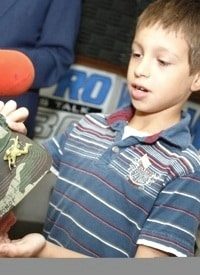
David Morales, a Coventry, Rhode Island, second grader, was recently banned from wearing a patriotic cap he made for a school project to school because it was adorned with plastic toy soldiers carrying tiny plastic “weapons.”
WPRI in Providence reported that David said he did not make the camouflage cap with soldiers on top as a fashion statement: It was meant to honor military members.
David’s teacher phoned his mother, Christan Morales, explaining that the miniature military figures brandishing even tinier, toothpick-sized rifles violated the school district’s zero-tolerance weapons policy.
"His teacher called and said it wasn’t appropriate," Morales told AP reporters. But she disagrees with the lack of sense behind the decision, saying that banning the cap "sent the wrong message to the kids, because it wasn’t in any way to cause any harm to anyone. You’re talking about Army men. This wasn’t about guns."
Coventry School Superintendent Kenneth R. Di Pietro related to the media that Denise Richtarik, the principal at the Tiogue Elementary School, told David’s family that the cap would be allowed if David replaced the soldiers holding weapons with others that were unarmed.
But the family had only one soldier represented without a weapon, and he was carrying binoculars. So in order to comply with the ban, David wore an unadorned, soldier-less baseball cap on the day of the special program — a meeting with pen pals from another school.
"Nothing was being done to limit patriotism, creativity, other than find an alternative to a weapon," said Di Pietro, stating that Principal Richtarik "wasn’t denying the patriotism.” "That just is the wrong and unfair image of one of our finest principals," he added.
On June 17, reported AP, Di Pietro and Richtarik met with Lt. Gen. Reginald Centracchio, adjutant general emeritus of the Rhode Island National Guard, at the general’s request.
Centracchio praised the Coventry school district for supporting the military in the past, including sponsoring a junior ROTC program, but he took exception to the decision to ban the cap. He also expressed hope that the incident would provide an opportunity for the distrcit to review its policies. "The American soldier is armed. That’s why they’re called the armed forces," said Centracchio. "If you’re going to portray it any other way, you miss the point."
Centracchio presented David with a medal for his patriotic efforts on June 18, along with a certificate that allows the boy to call himself an honorary brigadier general.
Such irrational fear of “weapons” reminds this writer of the old joke about the man who — lacking a piece of cheese with which to bait his mouse trap — used, instead, a picture of a piece of cheese. He caught a picture of a mouse!
The tiny, half-inch-long strips of plastic protruding from two-inch-high toy soldiers are no more “weapons,” than a picture of a piece of cheese is real cheese. Only in animated movies do such toys come to life and threaten anyone.
Such thinking is not unique to Coventry, Rhode Island, however. Earlier in the school year our grandson was sent to the principal’s office of his Rowlett, Texas, elementary school for engaging in the “dangerous” act of actually drawing battle scenes involving tanks and other military armaments. The principal thought this drawing was dangerous enough to confiscate as contraband and sent Kyle to the school’s counselor. (Incidentally, Kyle has a remarkable knowledge of World War II history, being able to name most of the conflict’s major battles and participants.)
Probably contributing to this young lad’s admiration for the military is the fact that his father served in the U.S. Marine Corps and currently is a civilian technician working at Kirkuk Air Base in Iraq. The school’s administration, obviously, does not share in this respect for our nation’s armed forces.
In contrast, this writer has quite distinct memories of class in the first grade during the 1954-55 school year, only 10 years after the conclusion of World War II and a year after fighting in Korea ended. In order to promote creativity, the teacher would pass out drawing paper several times a week and allow the children to draw with their crayons whatever their little hearts desired.
Now the girls were prone to making pictures of flowers, puppies, and kittens, but the boys would have none of such “sissy” subject matter. Almost without exception, the boys would use their crayons to recreate battle scenes they had seen watching the popular World War II-themed movies of the day or from the popular Victory at Sea TV documentary series.
Most of the boys would become quite animated when drawing pictures of U.S. battleships pointing enormously out-of-proportion guns at dive-bombing Japanese kamikaze pilots flying planes with the red, rising-sun “meatballs" on their wings! They would become so engrossed in their creations that they would make “rat-a-tat-tat” machine-gun sound effects while using red and yellow crayons to depict fire belching out of the muzzles of cannon and machine guns, demolishing the Japanese Mitsubishi Zeros.
If the teachers reacted at all to the little boys’ apparent enthusiasm for military battles, it was perhaps to smile in amusement. Most of them, after all, were probably married to men who had served their country at places like Normandy, Anzio, or Iwo Jima — or in operations supporting those who did.
One hopes that if a foreign enemy ever invades America, such fear of even representations of military weaponry will not have led to the complete disarmament of our nation, rendering us defenseless.
Photo: David Morales, 8, from Coventry, R.I., shows his decorated army cap during an appearance on WPRO-AM’s John DePetro radio show in East Providence, R.I. on June 18, 2010: AP Images



